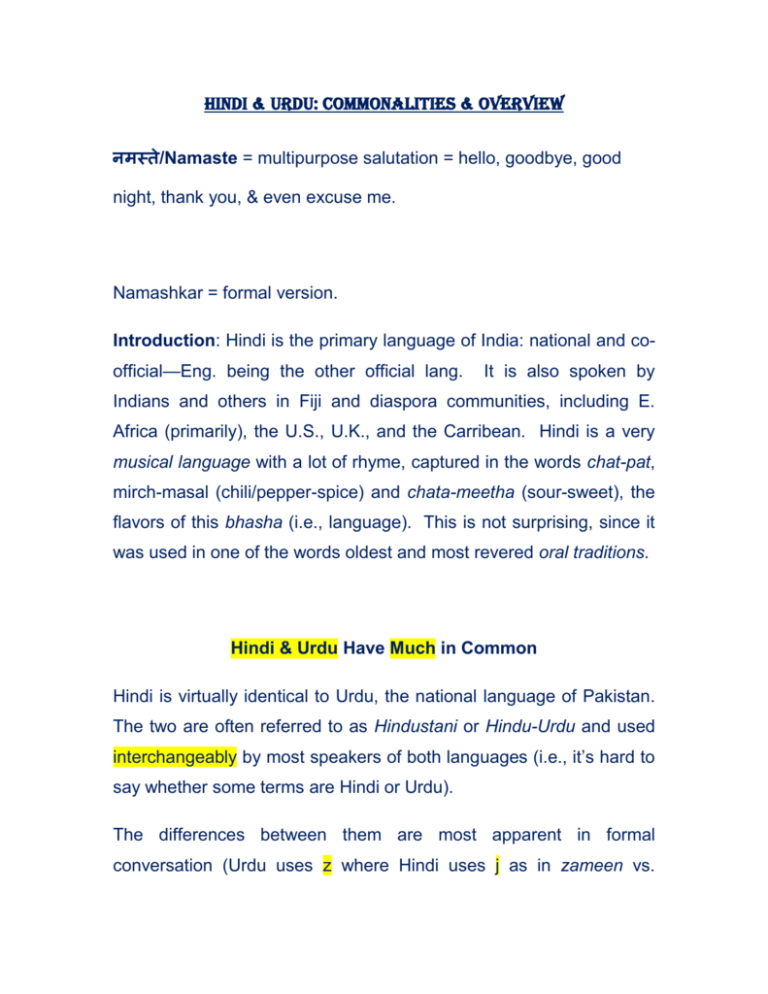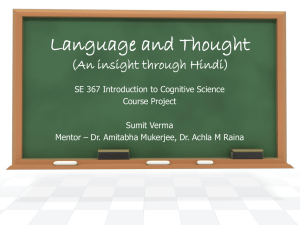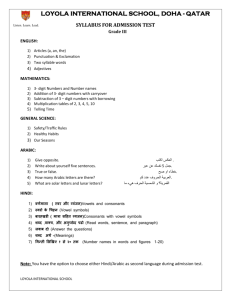Hindi-UrduOverview-Handout - mac-cae
advertisement

Hindi & Urdu: Commonalities & Overview नमस्ते/Namaste = multipurpose salutation = hello, goodbye, good night, thank you, & even excuse me. Namashkar = formal version. Introduction: Hindi is the primary language of India: national and coofficial—Eng. being the other official lang. It is also spoken by Indians and others in Fiji and diaspora communities, including E. Africa (primarily), the U.S., U.K., and the Carribean. Hindi is a very musical language with a lot of rhyme, captured in the words chat-pat, mirch-masal (chili/pepper-spice) and chata-meetha (sour-sweet), the flavors of this bhasha (i.e., language). This is not surprising, since it was used in one of the words oldest and most revered oral traditions. Hindi & Urdu Have Much in Common Hindi is virtually identical to Urdu, the national language of Pakistan. The two are often referred to as Hindustani or Hindu-Urdu and used interchangeably by most speakers of both languages (i.e., it’s hard to say whether some terms are Hindi or Urdu). The differences between them are most apparent in formal conversation (Urdu uses z where Hindi uses j as in zameen vs. jameen for earth, and Urdu uses more formal vocabulary—given its long oral poetry tradition during the 300-year Moghul period), as well as in writing. Urdu is written in Arabic script, Hindi is written left to right in a script called Devangari, the oldest recorded script in the world (3,000 B.C.). The necklace-like line on top of a word signals sound blending. Furthermore, Urdu vocabulary derives from Persian and/or Arabic, while Sanskrit is the primary source of Hindi words. Alphabet: The Devangari script employed by Hindi contains both vowels (10 basic ones and the borrowed /ri/) and consonants (40 basic ones) and is characterized by bars on top of the symbols. Hindi is highly phonetic; i.e. the pronunciation of new words can be scientifically predicted from their written form. This is in strong contrast to English, with the result that Hindi learners may struggle with English spelling. Phonology: In comparison with Englis,h Hindi has approximately half as many vowels and twice as many consonants. This leads to several problems of pronunciation. One difficulty is distinguishing phonemes in words such as said / sad; par / paw; vet / wet, etc. Words containing the letters th (this, thing, months) might cause Hindi learners the same kind of problems that they cause most other learners of English. The phoneme / / as exemplified by the s in pleasure is missing in Hindi and so some might pronounce it as “pleajure.” Consonants clusters at the beginning or end of words are more common in English than Hindi. This leads to errors in many Hindi speakers’ pronunciation of words such as straight (istraight), fly (faly), film (filam). Compared to English Hindi has weak but predictable word stress. Learners therefore have considerable difficulty with the irregular stress patterns of words such as photograph / photographer. Hindi learners are disinclined to 'swallow' unstressed syllables such as the first syllables in the words tomorrow, intelligent, remember, etc., and will often try to clearly articulate short, common words that are usually weakly stressed in English: has, and, was, to, etc. Indian English is heavily Hindi-flavored. It uses a mix of Hindi and English. We’ll see examples throughout this course. Grammar - Verb/Tense: Hindi has tenses that similar those used in English: present simple, past continuous, etc., but there is a lack of correspondence in their use to express various meanings. This leads to the very common overuse by Hindi learners of the present continuous when in English the present simple is required: I am always playing golf on Sundays. / I am not knowing the answer. Since Hindi does not have the auxiliary do, learners are prone to asking questions by means of intonation alone: She has a brother? and to making mistakes such as When you got married? or She not eat meat? There is no definite article (i.e., the) in Hindi, and the number one is commonly used where English uses the indefinite article. As to be expected, these differences make it difficult for many Hindi learners to uses articles in English. There are two aspects of word order that are different in Hindi and English. Firstly, the standard word order is in Hindi Subject-ObjectVerb as against Subject-Verb-Object in English. Secondly, in Hindi the preposition comes after the noun or pronoun it qualifies (i.e., it is more correctly called a 'postposition'. There does not seem to be undue interference between the two languages in these areas. However, in common with most learners of English, Hindi nativespeakers have problems with the correct choice of the English preposition itself. Mistakes such as They were sitting on (at) the table are typical. Vocabulary: Hindi has borrowed many English words, which is a help to the beginner who quickly wants to acquire a large vocabulary. However, the pronunciation of many of the loan words has changed in Hindi. The interference this causes can lead to Hindi learners not being comprehensible when they use the words in oral English. The Indian Influence in (Old) English English belongs to the Indo-European family of languages, the largest, and Sanskrit (the mother of Hindi) is the source bhaksha/भाषा/language. Sanskrit loanwords in English include almost all the words for family (e.g., ma(ma)/mother from mata, father/pa(pa) from pita), reflecting a communal culture, and many others, including the (Arabic) numbers (0 to 10), nam for name, and nama for named--emphasizing identity, belonging, and kinship. While some, like bazaar, shampoo, jungle, bhaloo (bear) and cheatah have retained their original sounds, many have been anglicized (e.g., Cashmere vs. Kashmir(i), eight vs. aath; grass vs. ghass, cona vs. corner, and sabun/soap vs. savon and sabon, in French and Spanish, respectively).





